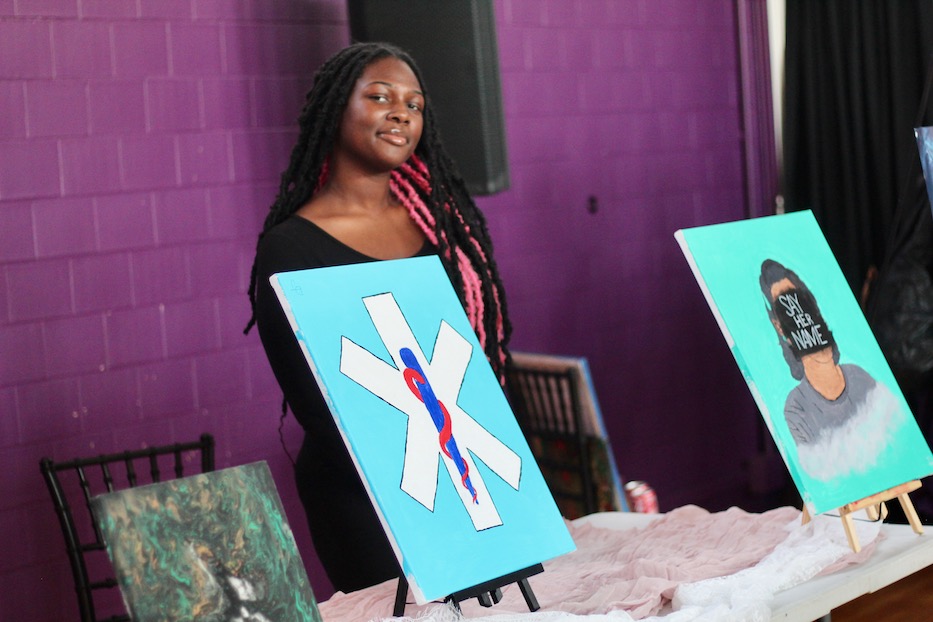
Dance | Hamden | Music | Protest | Arts & Culture | Visual Arts | Black Lives Matter | ConnCORP | Arts & Anti-racism
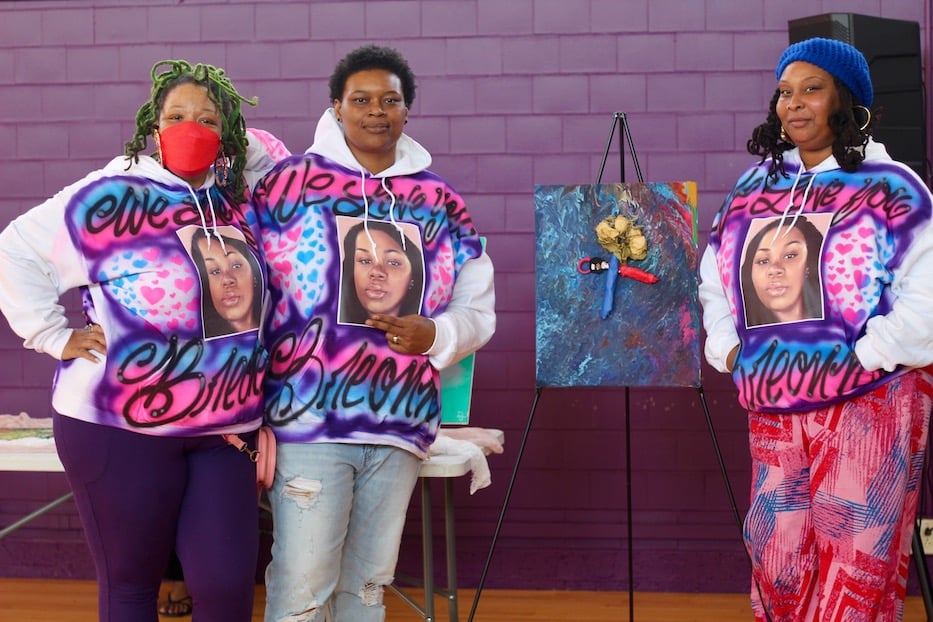
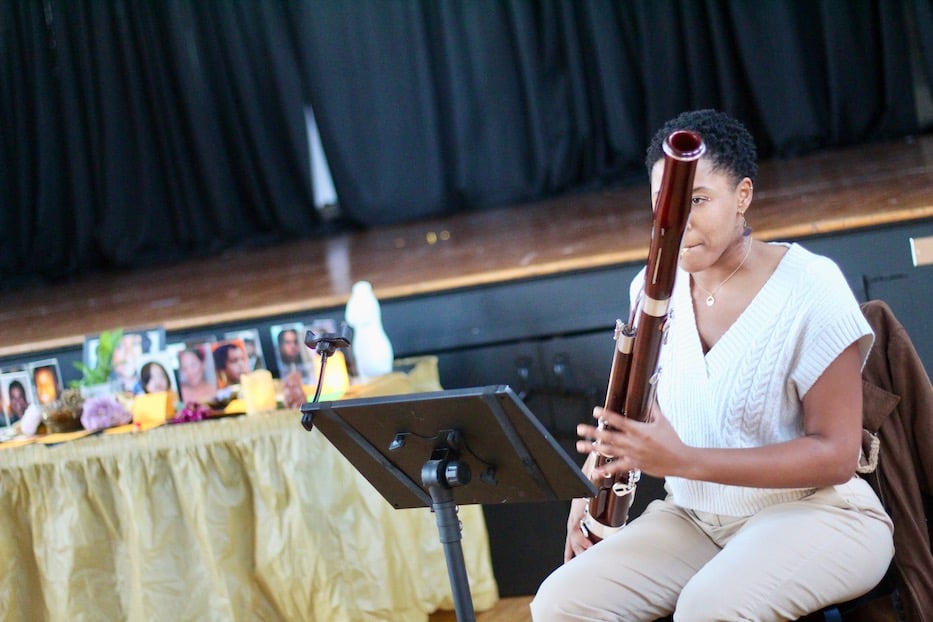
Top: Ala Ochumare-Harris, MiAsia Harris, and Sun Queen. Bottom: Bassoonist Damali Willingham. Lucy Gellman Photos.
The sound of the bassoon filled the gym, a low moan that bloomed across the floor and wrapped itself around tables that filled the center of the room. The notes climbed, and a listener could almost see them swirling above an altar, where candles flickered in between two dozen portraits of women gone too soon. Close to the stage, musician Damali Willingham leaned in to the instrument, giving it their full attention. In the impromptu audience, a listener could have heard a pin drop.
Saturday, Willingham was just one of the artists who graced the LAB at ConnCORP for “Sovereignty: Breonna’s Legacy Art Show,” a multimedia collaboration with the New Haven Symphony Orchestra, Black Lives Matter New Haven (BLMNHV), Liberation U, The Sun Experience, and Long Wharf Theatre. Designed as a space to celebrate, honor, and remember Black women and femmes, it came one day before the New England premiere of Joel Thompson’s “breathe/burn: an elegy for solo violoncello and orchestra,” at Southern Connecticut State University.
The piece is a co-commission between the New Haven Symphony Orchestra and Chicago Sinfonietta. During the same concert, the NHSO also played Florence Price’s “Symphony No. 1,” Mark Adamo’s “Last Year: Concerto for Cello and String Orchestra,” and Daniel Bernard Roumain’s “Why Did They Kill Sandra Bland?” Read about the concert in the New Haven Independent here.
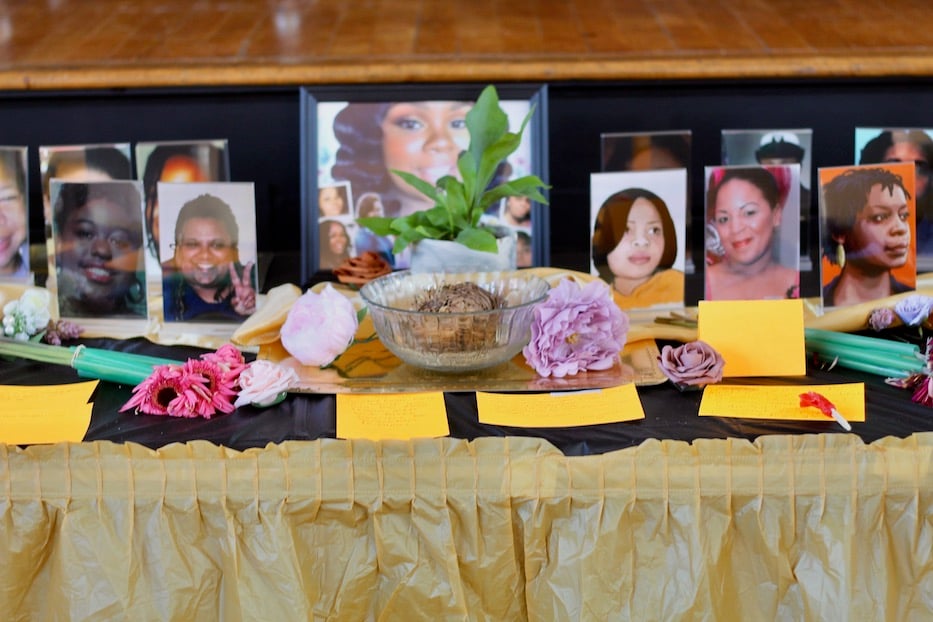
An altar honoring not only Breonna Taylor, but all Black women and femmes lost too soon, sat directly in front of the stage for the entirety of the afternoon.
“You being here and able to take up space is what we wanted and needed,” said Liberation U’s Ala Ochumare-Harris, a co-founder of Black Lives Matter New Haven with the artist Sun Queen, from the stage. “We are here in our liberation, centering our joy, centering our ability to live. This is also organizing—art can create and shift movements.”
Around the room, those words sprang to life over and over again, from tables celebrating Black New Haven and Hamden artists to spoken word, dance, and music that made the space feel holy and healing. Close to the stage, a series of paintings from poet and BLMNHV co-founder Sun Queen and 15-year-old artist Danielle Douglas set the tone, centering Taylor’s legacy. From the back walls, all painted a regal shade of purple, the smells of warm potstickers and veggie empanadas from ConnCAT’s Orchid Café floated through the room.
In one work, a turquoise-colored background gave way to an outline of Taylor’s head and shoulders, her neat swoop of hair unmistakable from the canvas. Where her face might otherwise have been, Douglas had painted the words Say Her Name in black and white, the statement vivid even from across the room. Beside it, Queen had marbled thick layers of paint, then added scissors and dried flowers, as a nod to Taylor’s career as an EMT.
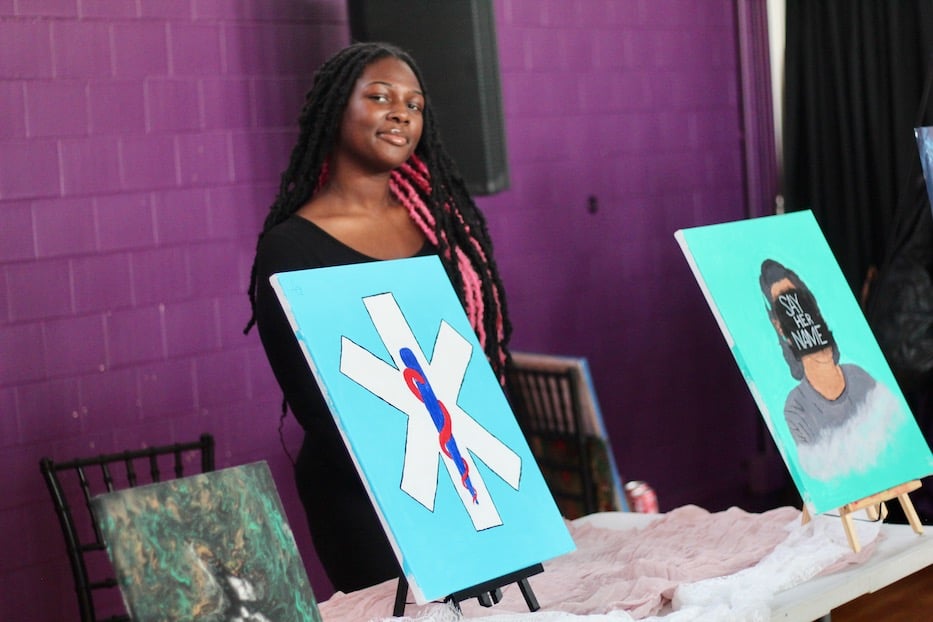
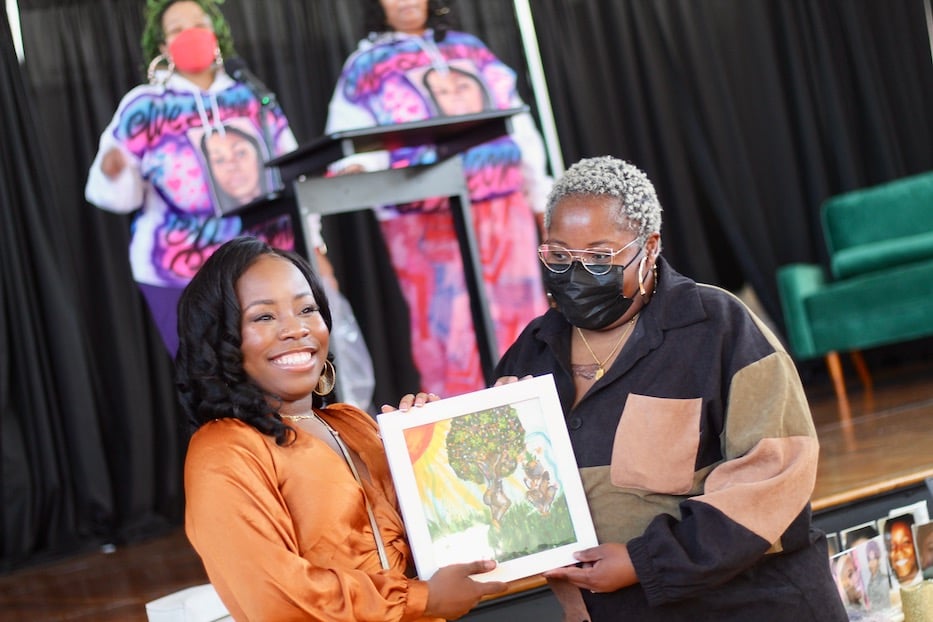
Top: The artist Danielle Douglas, who is a student at Hamden High School. Bottom: Artist Akosua Aidoo of Akosua's Wonderful World of Art with Hartford resident Yoda Exavier. A social worker in Hartford, Exavier said she came to support the cause.
As a founder of BLMNHV, Queen has been calling attention to Taylor's untimely death since her murder in March 2020. But she did not turn to painting until recently. As she worked on the canvas, Queen folded in references to the trauma shears Taylor kept on her hip and the bouquet of flowers she cradled in one arm, just over a blue-and-white certificate of completion, in a now-viral photograph from her EMT graduation ceremony in Louisville.
“I needed something else for when I was stuck on the words and needed to release,” said Queen, who performed Sunday alongside cellist Jeffrey Zeigler. Moments before, she had urged attendees to consider the meaning of sovereignty in their own lives. “With the pouring paints, it gives me freedom.”
One table over, artist Amira Brown held onto that same notion, displaying work that they completed almost two years ago, but did not show at the time. Across the table, a series of gently used purses and handbags peeked out into the room, their surfaces painted and chalked with a melange of figures and words in different media.
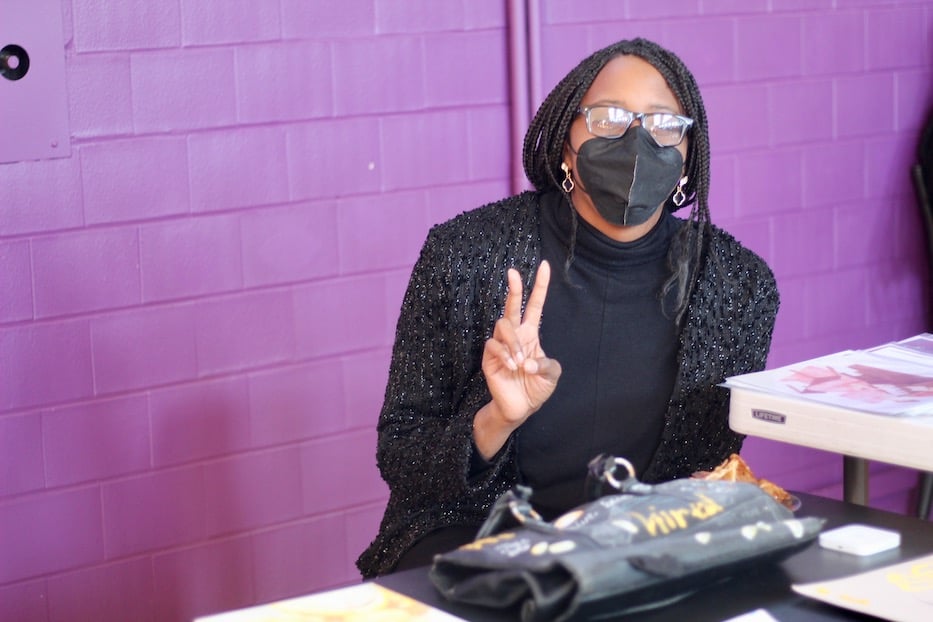
Artist Amira Brown. “She was working, saving lives, and then they couldn’t save hers.”
Brown, who founded Bailout Gallery just months after Taylor lost her life, called them a statement on what the churn of capitalism does to all bodies, and especially to Black people and Black women. On one, the words Hi and Hired nearly glowed gold beneath the gym’s bright lights. On another, an inch-high figure trudged forward in the blue-and-pink of the Trans Pride flag, her head turning to one side.
“They had me thinking of commodity and value,” Brown said. “She was working, saving lives, and then they couldn’t save hers.”
A few feet away, attendees stopped to talk with Annalisa Correia, an aspiring comic book and cartoon artist who is currently finishing her senior year at the University of New Haven. While Correia has been making art since she was a kid, it’s only been in the past four years that she has become serious about it. In her work—largely painting and printmaking—“I just try to evoke a specific emotion,” whether it’s wonder at what the world could be, or frustration and fatigue at what it sometimes appears to be.
In a framed portrait to her right, a young girl looked toward a television set, the room soaked in dramatic shades of indigo and chartreuse. Where a tv program might otherwise have been, orange and yellow flames erupted from the box, setting her face aglow. In the background, three lights winked on, illuminating something beyond the frame. Behind her, another canvas channeled Kehinde Wiley, with a bold, wallpaper-like background and face in profile.
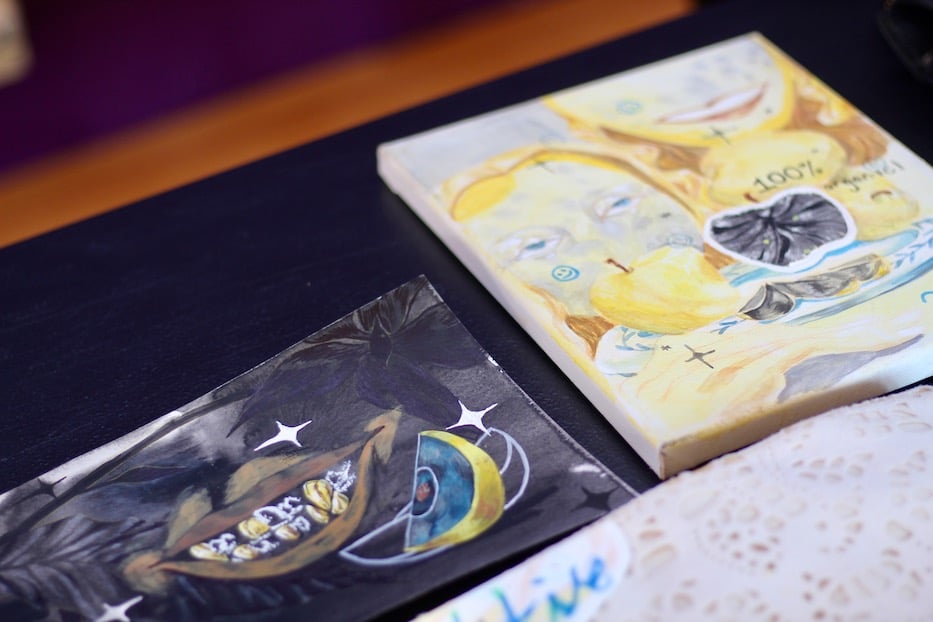
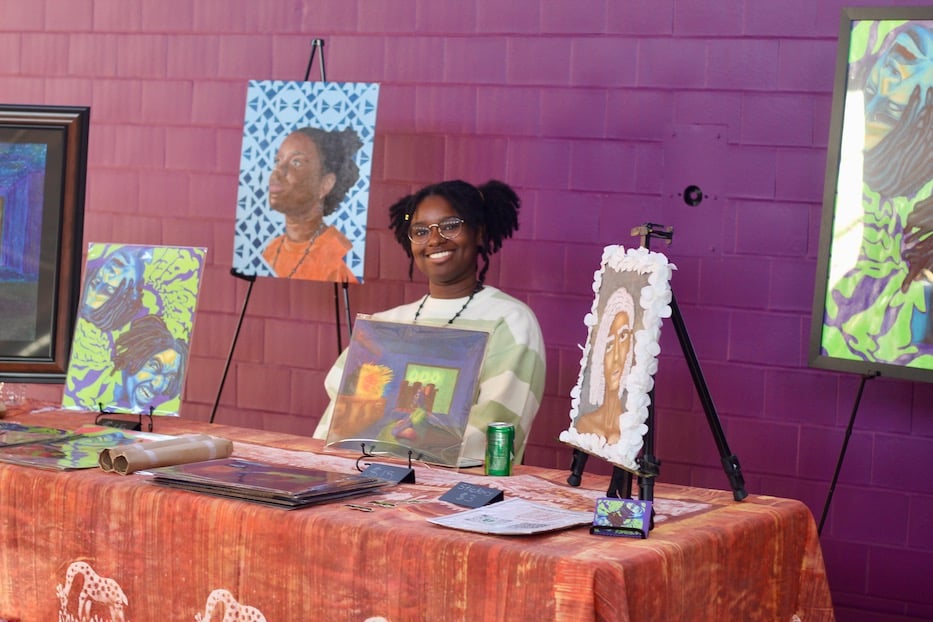
Top: Brown's work. Bottom: Artist Annalisa Correia, who is a senior at UNH.
“When I draw and when I make art, I try to honor Black women,” she said, adding that part of her mission is to keep names like Taylor’s alive through the creative work she does. “Being in this place with Black women and Black femmes, I feel like I belong here. I definitely appreciate events like this.”
“Knowing she [Breonna Taylor] get justice, we’re working toward a future where that doesn’t happen,” she added.
Elsewhere, artists lifted that message in spoken word, song and dance, all of them taking time to honor Taylor’s legacy three and a half years after police shot her to death in her Louisville apartment. Taking the stage as her daughter danced amidst a cluster of hula hoops, poet Attallah Sheppard reimagined a letter to 19th-century America as told through the eyes of the Statue of Liberty—who in this case was also a Black woman.
As she left line breaks dangling over the edges of the stage, attendees came in closer, hanging on to every word.
“I’m being weighed down by broken chains at my feet/I’m reminded of how slaves were never really free,” she read. “Guess that’s why Black lives don’t matter quite yet—No No disrespect, America, but when you stand this tall/There’s only so much that you’ll fall for/And I bet you wish I’d fall for you.”
For over five minutes, an attendee could have heard a pin drop between her words. Only snaps and the occasional Mmmm filled the room. As they listened at a hi-top table close to the stage, State Rep. Robyn Porter and artist, writer and activist Marcey Lynn Jones listened carefully. Both praised the event when Sheppard had stepped down from the stage, and Queen and Ochumare-Harris prepared for the next performer.
“I looked at that painting [of Breonna Taylor] and talk about the emotions,” said Porter, who represents New Haven and Hamden in the state legislature, of Douglas’ canvas reading Say Her Name. “Being able to be in an open and vulnerable space that is safe for all of us is powerful. It keeps her spirit alive … This is spiritual. These”—she motioned to artists around the room—“are the shoulders we will one day be standing on.”
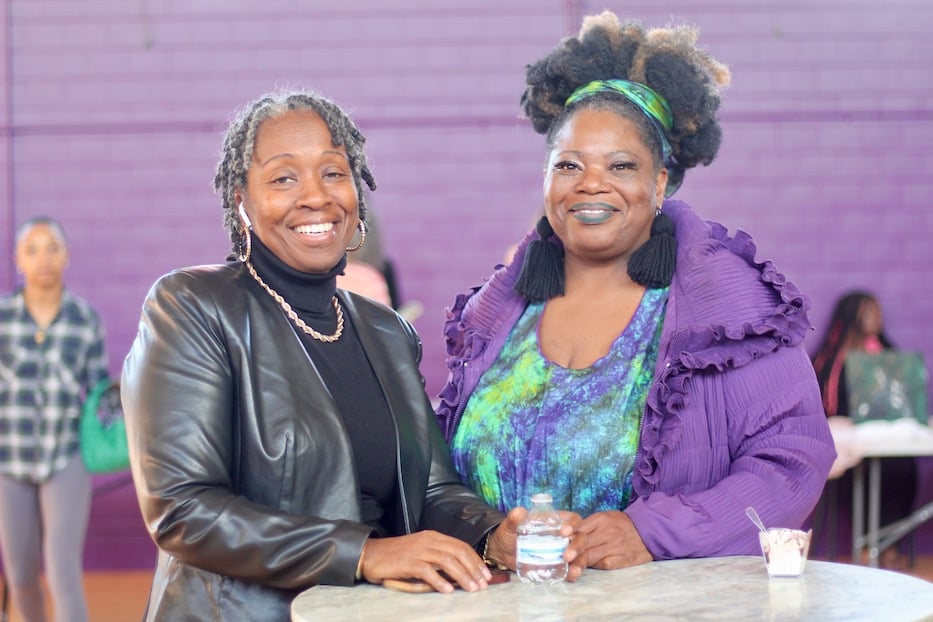
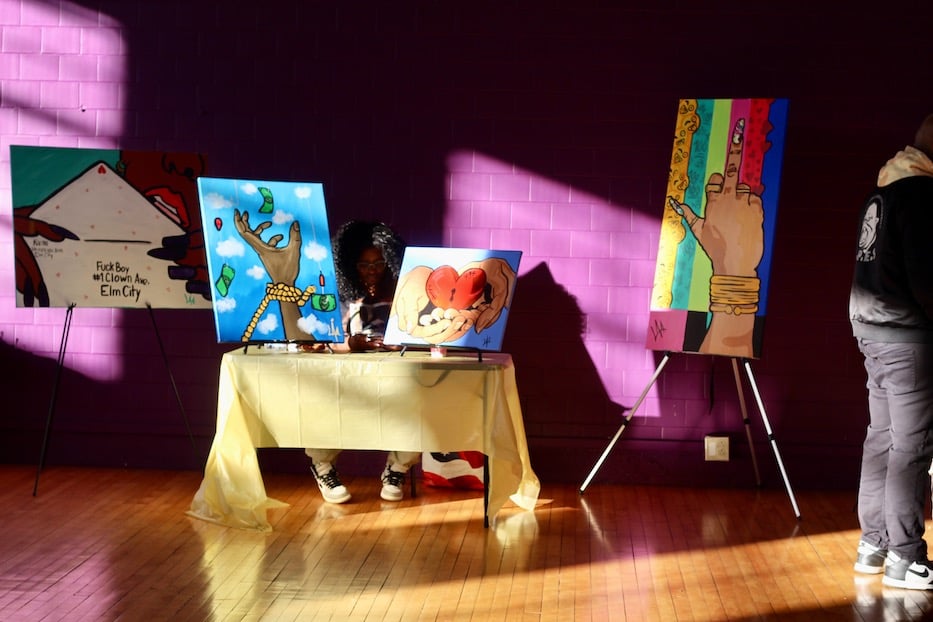
Top: State Rep. Robyn Porter and Marcey Lynn Jones. Bottom: Artist Jade Streater.
“It’s amazing,” added Jones, who also attended a discussion on Taylor’s legacy with BLMNHV and the NHSO the week prior. Echoing Porter, she said she was thrilled to be in a space with so many artists. Each year, she tries to find new work to put in her windows during Kwanzaa, which this year runs December 26 through January 1. Saturday, she walked away with half a dozen pieces of new artwork.
One of the artists who she connected with was Jade Streater, whose paintings beckoned from the back of the gymnasium. From between two bright canvases, Streater smiled at attendees, poking her head between them for bits of conversation. But it was the canvas to her right, a middle finger rising through bands of technicolor, that caught many people’s attention. Titled “Censored Beep,” Streater said it was designed specifically for people who have not supported her career as an artist.
Back at the front of the room, dancer Gwendolyn Wilkins glided to the center of the stage, listening carefully as Emeli Sandé’s “Read All About It” began to play over the speakers. Leaning forward, she extended her arms in a kind of offering, bringing attendees in closer as she moved. She began to spin across the stage, her socked feet a blur of blue and white as she lowered herself to the ground (watch the performance here).
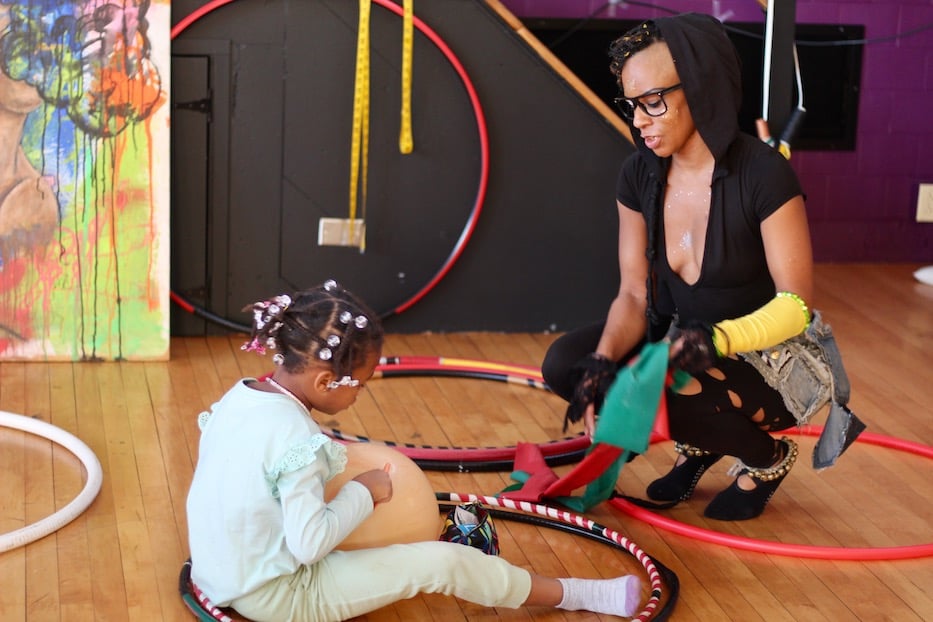
Sheppard's daughter with Diamond Tree, who leads Hood Hula.
Kneeling in front of the communal altar, she lowered herself to the floor as if in prayer, and then began to rise, letting her shoulders guide each movement. As she lifted off and took flight once more, the dance became elegiac, communicating Taylor’s heavy, palpable and too-premature absence with no words at all.
“I feel like it’s another way of us expressing ourselves for the people who can no longer speak,” said Wilkins after the performance. “We’re here to be the voices for them.”
That remained true throughout the afternoon, flowing from performances by poet Draya Syns and Hood Hula’s Diamond Tree to artist giveaways that sent attendees home with donated pieces of artwork. Before wrapping up the afternoon, NHSO Board Member Zanaiya Léon introduced Willingham, who she had met just moments before during a chance encounter in the hallway.
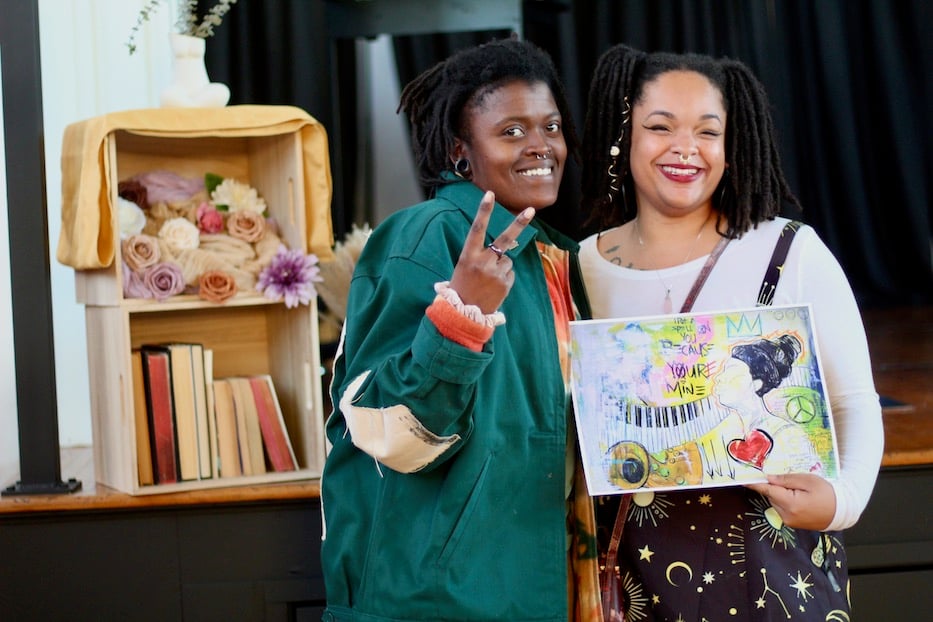
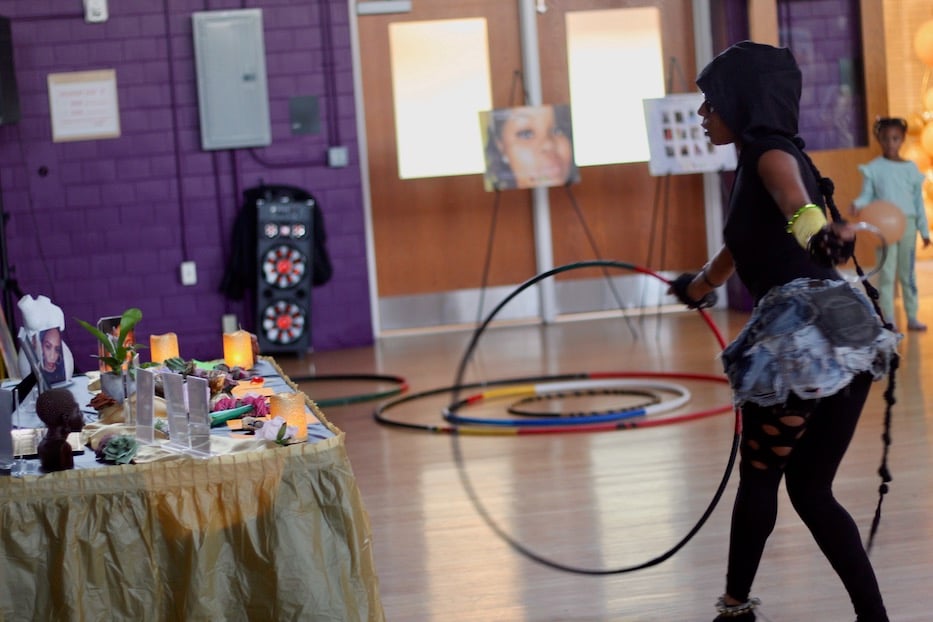
Top: The artist Candyce Marsh John (Marshun Art) and poet Draya Syns, who performed spoken word (video below) towards the end of the afternoon. Bottom: Diamond Tree performs a routine to Cynthia Erivo's "Stand Up."
A conducting fellow at Greater CT Youth Orchestras in Bridgeport, Willingham had been at ConnCORP for a different function, they later said. But when they heard about “Sovereignty” from Léon, it piqued their attention. Their piece “Reclamation,” written as a work for younger musicians, is about the need for Black women and femmes to take up space.
“I’m really excited that this is the type of program that we’re [the NHSO] able to do,” Léon said as Willingham unclasped their instrument case and methodically assembled their bassoon (“Okay double reed!” Queen shouted from a nearby table, sending a welcome wave of laughter into the room as Willingham warmed up).
As the notes rose, it was as if Willingham was weaving a tapestry, searching at both ends of the bassoon’s register for the right threads of sound, the lengths and holds that would make the piece hang together.
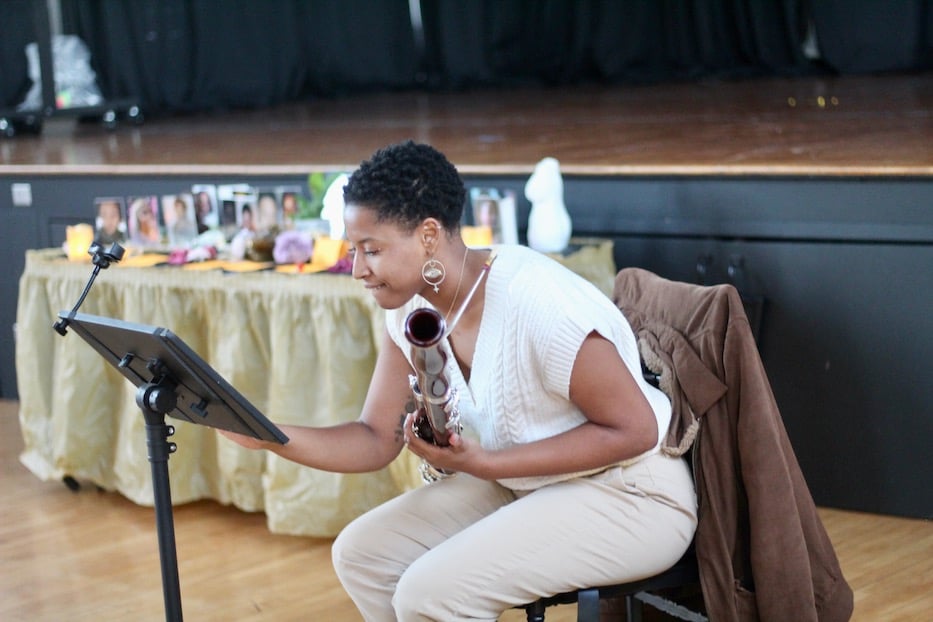
Willingham later said that they built the composition—of which they only played a short excerpt—around the human-ness and range of expression that they hear in the bassoon’s voice. As they played, the silences seemed just as weighted and meaningful as the sound.
“Whenever I write music, I write with my identities at the center of the piece,” they added. “This is art in honor of my Blackness, my ancestors, my community.”
For more from Saturday's event, check out the Arts Council's Instagram or watch the videos above.

